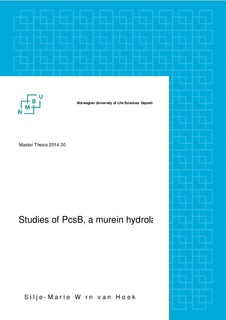Studies of PcsB, a murein hydrolase essential for cell division in Streptococcus pneumoniae
Master thesis
Permanent lenke
http://hdl.handle.net/11250/216793Utgivelsesdato
2014-08-06Metadata
Vis full innførselSamlinger
- Master's theses (KBM) [891]
Sammendrag
The bacterial cell wall with its peptidoglycan layer is essential for cells to maintain their
shape and for protection against osmotic pressure. The cross-linked polymer peptidoglycan forms the scaffold of the cell wall. In addition, cell wall components are required for a numerous physiological processes including cell growth and division.
Streptococcus pneumoniae has a typical Gram-positive cell wall with an ovoid shape and are typically arranged in pairs (diplococci) or chains. Peptidoglycan synthesis in S.
pneumoniae is believed to occur in a combination of peripheral and septal synthesis in the mid-cell regions of dividing cells. The murein hydrolase PcsB is, amongst other, thought to play a key role in splitting of the cross wall peptidoglycan between daughter cells. PcsB is highly conserved among group B streptococci and the deletion of the pcsB gene results in misplacement of the division septum, reduced growth rate and abnormal cell shape.
Consequently, studies have shown that PcsB is essential for proper cell division and
proliferation in S. pneumoniae. In the present study, PcsB was purified to produce PcsB-specific antibodies, which will be a valuable tool for studying PcsB in S. pneumoniae. It was shown that the PcsB-specific
antibody has high specificity towards PcsB. Growth studies performed to determine the
correlation between amounts of cell-associated PcsB and secreted PcsB showed that PcsB is a relatively abundant protein in S. pneumoniae. Quantitative studies showed that PcsB
accumulates outside the pneumococcal cells as they grow and divide, which is in
agreements with recent studies suggesting how the mechanisms of PcsB work.
Furthermore, the ComRS depletion system was used to determine whether the amounts of cell-associated PcsB and secreted PcsB remained stable or were degraded. Growth and morphological studies confirmed that the depletion of PcsB had a negative effect on the
cells viability. Cells showed abnormal shape, clumping and the formation of longer chains demonstrating PcsB’s importance in cell division. These results contribute to strengthen the theories of PcsB’s involvement in cleaving peptidoglycan in the septal cross wall to
separate the two daughter cells during cell division.
Den bakterielle celleveggen består blant annet av et peptidoglykan-lag som har en
essensiell rolle ved å opprettholde morfologien og beskytte cellen mot osmotisk trykk. Det er kryssbundet peptidoglykan som danner skjelettet i celleveggen. Celledeling og
celleveggsyntese hos bakterier er nøye regulert og koordinerte prosesser hvor mange
komponenter inngår. Streptococcus pneumoniae har en typisk Gram-positiv cellevegg med ovoid morfologi og
danner ofte par (diplokokker) eller kjeder. Celleveggsyntesen i S. pneumoniae skjer i en
kombinasjon av perifer og septal syntese og foregår i midten av celle regionen. PcsB er
peptidoglykan hydrolase som virker å ha en viktig rolle i splittingen av det septale
peptidoglycanlaget når datterceller skal skilles. PcsB er svært konservert blant klasse B
streptokokker og studier har vist at PcsB er avgjørende for riktig celledeling og spredning i S. pneumoniae. Delesjon av pcsB genet førrer til feilaktig celledeling, redusert vekst og
unormal celle morfologi. I dette arbeidet ble PcsB renset for å produsere PcsB-spesifikke antistoff, noe som vil være et viktig verktøy for å studere PcsB i S. pneumoniae. PcsB-spesifikke antistoffer viste seg å ha tilfredsstillende spesifisitet og sensistivitet. For å bestemme sammenhengen mellom celle-assosiert PcsB og sekretert PcsB, ble det utført vekstforsøk. Det ble vist at PcsB
finnes i rikelige mengder i S. pneumoniae. Beregninger viste at PcsB akumulerte utenfor
cellene ettersom bakteriene deler seg , noe som er i tråd med nylig forskning om hvordan man tror PcsB sin mekanisme fungerer. Videre har ComRS-depletionsystemet blitt brukt til å fastslå om mengde celle-assosiert PcsB og sekretert PcsB opprettholdes eller degraderes. Vekst- og morfologistudier indikerte at depletion av PcsB hadde en negativ effekt på
cellenes levedyktighet. Cellene viste unormal morfologi, klumpdannelse og dannet lengre kjeder noe som viser PcsB sin betydning i celledeling. Dette viser viktigheten av PcsB i
celledeling hos pneumokokker. Disse resultatene bidrar med å styrke teorier om PcsBs rolle i peptidoglykan kløyving i den septale ”cross wall” for å skille de to dattercellene under
celledeling.
